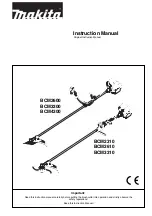
-28-
5.7
Sawing with FLEXI rail
Danger
The support rail is pretensioned
and may snap open in an
uncontrolled manner - risk of injury.
It should therefore be securely held
with both hands during opening
and closing.
Initial operation
Trim the splinter guard 4 (Fig. 4) before initial
operation:
Place the FLEXI rail on a flat support.
Set the cutting depth to approx. 3 mm ( 1/8 in. )
and the angle scale to 0°.
Turn on the machine and push it evenly in the
direction of the cut.
The resulting cut edge on the splinter guard serves as
tracing edge for straight cuts and bevel cuts.
Place the FLEXI rail onto the workpiece. Knock
against the workpiece and align it on the tracing.
So as to fix the FLEXI rail, tighten the two clamping
claws 1 (Fig. 6) with the screw clamps.
Operating method
Set the cutting depth and cutting angle on the
machine.
Place the machine on the start of the FLEXI rail
such that the guide elements 1 (Figure. 4) of the
rail engage in the base plate groove.
Turn on the machine and push it evenly in the
direction of the cut.
Do not clean the FLEXI rail with
solvents. Non-skid coating may get
damaged.
5.8
Sawing shadow gaps
The minimum shadow gap width is:
-
if used without parallel stop 13 mm (33/64 in.)
-
if used with parallel stop 14 mm (35/64 in.) (at
cutting depth of 0 - 32 mm / 0 – 1 ¼ in.)
-
if used with parallel stop 18 mm (45/64 in.) (at
cutting depth of 32 - 42 mm / 1 ¼ - 1 21/32 in.)
Set the required cutting depth.
Retract the retractable saw guard with the lever
2 (Fig. 3) and set the machine onto the first
fitted workpiece.
Switch on the machine and push the machine
evenly in cutting direction, in addition using the
extraction device.
5.9
Sawing with parallel stop
The parallel stop 4 (Fig. 1) serves to cut parallel to an
already existing edge. The limit stop can be attached
to the left or right of the machine. The cutting range
on the right-hand side amounts to approx. 65 mm (2
9/16 in.) and on the left-hand side to approx. 250 mm
(9 27/32 in.).
You can adjust the cutting width after
unfastening the wing screws 9 (Fig. 2) by
moving the limit stop accordingly and afterwards
refastening the wing screws.
In addition, by simply turning it over (guide surface for
the workpiece edge is pointing upwards), the parallel
stop can be used as double support to improve
machine guidance. Now the machine can be guided
along a lath that is fastened on the workpiece.
5.10
Sawing according to tracings with guide rail
When sawing according to tracing, the right edge of
the guide rail serves as tracing indicator. This also
applies to bevel cuts. Please take note of Section 5.4.
For sawing, place the guide rail onto the
workpiece.
Switch on the machine (see Chapter 5.2) and
slide the machine evenly in cutting direction.
When the cut is completed, switch off the saw
by releasing the switch trigger 2 (Fig. 1)
While it is resting on the workpiece, pull the
machine back into home position and in this
position remove it from the workpiece.
Proceeding in this manner ensures that the
retractable saw guard is completely closed.
















































